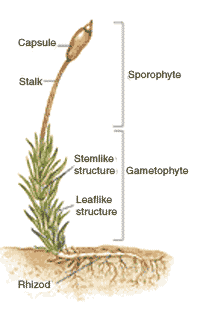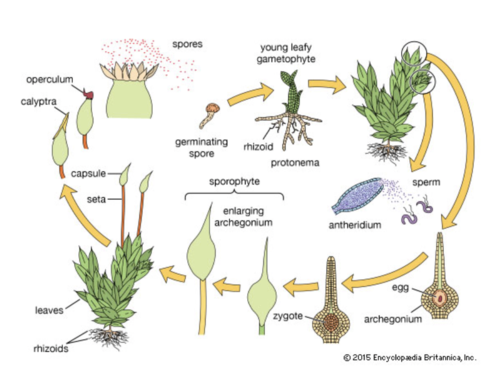Moss: Difference between revisions
Jump to navigation
Jump to search
| Line 25: | Line 25: | ||
</gallery> | </gallery> | ||
=References= | ==References== | ||
:[1] Asher, Beth. “Describe the Structure of a Moss Plant.” Hunker, [[https://www.hunker.com/12000232/describe-the-structure-of-a-moss-plant]]. | :[1] Asher, Beth. “Describe the Structure of a Moss Plant.” Hunker, [[https://www.hunker.com/12000232/describe-the-structure-of-a-moss-plant]]. | ||
:[2] “Bryophytes.” Prentice Hall Biology, [[https://www.jayreimer.com/TEXTBOOK/iText/products/0-13-115516-4/ch22/ch22_s2_1.html]]. | :[2] “Bryophytes.” Prentice Hall Biology, [[https://www.jayreimer.com/TEXTBOOK/iText/products/0-13-115516-4/ch22/ch22_s2_1.html]]. | ||
Revision as of 13:35, 7 May 2021

| Moss | |
|---|---|
| Kingdom: | Plantae |
| Phylum: | Bryophyta |
- Mosses are a group of small, non-vascular, plants with a cosmopolitan distribution belonging to the taxonomical division Bryophyta. They are typically 0.2–10 cm (0.1–3.9 in) tall, and have a waxy cuticle to prevent water loss. Mosses can typically be found forming dense mats in wet/shady habitats. Some species can be extremely resilient and tolerate many toxins, which is why they can also be found in urban brownfields, growing in the cracks of roadways, or on the sides of buildings. Moss offers a food source and habitat for macro and micro invertebrates. They create microhabitats that are essential to some species of soil arthropods. [10]
Structure
- Moss lacks vascular tissue, which is what other plants use to transport water and nutrients throughout them. Because they lack this tissue, they do not have flowers, roots, or stems. Instead, it has rhizoids, which act like roots holding the cluster in place. Without vascular tissue, water is transported from cell to cell by diffusion. The capsules are the sex organs, and where the spores come out. The stemlike structure supports the leaflike structures, called phyllids. These are the part of the plant that photosynthesize.
Life Cycle

- Moss have two parts to their life cycle. The first part, called sporophyte, is the stage where spores are produced. The spores are carried by wind to populate other areas. The second stage, called gametophyte, is after the spores found a place to grow. They develop male and female sex organs, which allow for reproduction. The male sex organ is an antheridial head, which contains sperm. The female sex organ is called an archegonial head, and each finger contains one egg. When it rains, the water splashes the sperm out of the antheridial head, and they swim to the eggs through water droplets. Water is essential in the reproduction of moss, which is why it can only grow in moist environments.
Environmental Role
- Mosses play an important part in stabilizing soil, and reducing erosion. Their rhizoids grip the ground and can hold on to clay, gravel, and sandy soil substrates. Moss is resilient and can withstand many toxins and heavy metals that might be in rainwater run-off or already present in the soil. Toxic elements like mercury, iron, and lead can be filtered through moss, making mosses a useful component in the bioremediation of areas. In addition to heavy metals, moss can filter other pollutants like excess sediment and salt used on roadways. Moss has the ability to create humid microhabitats, where plant seeds can easily germinate and soil arthropods can flourish. [10]
- In the garden, moss can be used as a natural pesticide. Moss has internal anti-herbivory compounds, which cause it to taste bad, especially to deer.
References
- [1] Asher, Beth. “Describe the Structure of a Moss Plant.” Hunker, [[1]].
- [2] “Bryophytes.” Prentice Hall Biology, [[2]].
- [3] Lizarazo, Andres. “Moss to Ferns.” SlideShare, 23 Apr. 2014, [[3]].
- [4] Martin, Annie. “5 Environmental Benefits of Moss Gardening.” Timber Press, 9 Sept. 2015, [[4]].
- [5] McLintock, A. H. “Polytrichum, Showing Both Male and Female Gametophytes as Separate Plants.” An Encylcopedia of New Zealand, 1966, [[5]].
- [6] “Moss.” Basic Biology, 23 May 2015, [[6]].
- [7] “Moss Facts.” Soft Schools, [[7]].
- [8] “Moss.” Wikipedia, 21 Mar. 2019, [[8]].
- [9] Stein Carter, J. “Primitive Plants: Mosses, Ferns, and Allies.” Biology Clermont, 11 July 2017, [[9]].
- [10] Gerson, U. 1969. Moss-Arthropod Associations. The Bryologist 72:495–500.